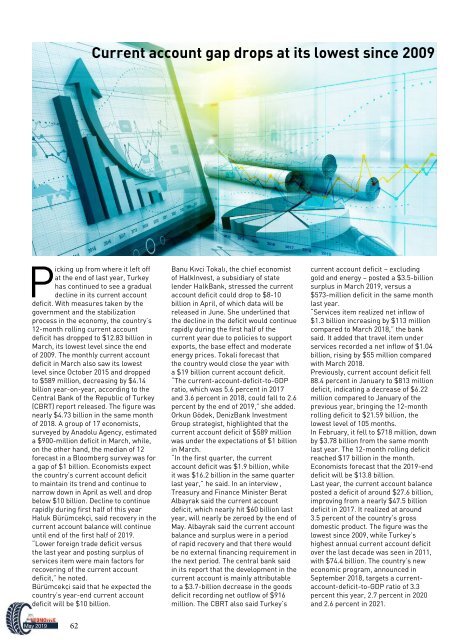Automotive Exports May 2019
Automotive Exports May 2019
Automotive Exports May 2019
You also want an ePaper? Increase the reach of your titles
YUMPU automatically turns print PDFs into web optimized ePapers that Google loves.
Current account gap drops at its lowest since 2009<br />
Picking up from where it left off<br />
at the end of last year, Turkey<br />
has continued to see a gradual<br />
decline in its current account<br />
deficit. With measures taken by the<br />
government and the stabilization<br />
process in the economy, the country’s<br />
12-month rolling current account<br />
deficit has dropped to $12.83 billion in<br />
March, its lowest level since the end<br />
of 2009. The monthly current account<br />
deficit in March also saw its lowest<br />
level since October 2015 and dropped<br />
to $589 million, decreasing by $4.14<br />
billion year-on-year, according to the<br />
Central Bank of the Republic of Turkey<br />
(CBRT) report released. The figure was<br />
nearly $4.73 billion in the same month<br />
of 2018. A group of 17 economists,<br />
surveyed by Anadolu Agency, estimated<br />
a $900-million deficit in March, while,<br />
on the other hand, the median of 12<br />
forecast in a Bloomberg survey was for<br />
a gap of $1 billion. Economists expect<br />
the country’s current account deficit<br />
to maintain its trend and continue to<br />
narrow down in April as well and drop<br />
below $10 billion. Decline to continue<br />
rapidly during first half of this year<br />
Haluk Bürümcekçi, said recovery in the<br />
current account balance will continue<br />
until end of the first half of <strong>2019</strong>.<br />
“Lower foreign trade deficit versus<br />
the last year and posting surplus of<br />
services item were main factors for<br />
recovering of the current account<br />
deficit,” he noted.<br />
Bürümcekçi said that he expected the<br />
country’s year-end current account<br />
deficit will be $10 billion.<br />
Banu Kıvci Tokalı, the chief economist<br />
of HalkInvest, a subsidiary of state<br />
lender HalkBank, stressed the current<br />
account deficit could drop to $8-10<br />
billion in April, of which data will be<br />
released in June. She underlined that<br />
the decline in the deficit would continue<br />
rapidly during the first half of the<br />
current year due to policies to support<br />
exports, the base effect and moderate<br />
energy prices. Tokali forecast that<br />
the country would close the year with<br />
a $19 billion current account deficit.<br />
“The current-account-deficit-to-GDP<br />
ratio, which was 5.6 percent in 2017<br />
and 3.6 percent in 2018, could fall to 2.6<br />
percent by the end of <strong>2019</strong>,” she added.<br />
Orkun Gödek, DenizBank Investment<br />
Group strategist, highlighted that the<br />
current account deficit of $589 million<br />
was under the expectations of $1 billion<br />
in March.<br />
“In the first quarter, the current<br />
account deficit was $1.9 billion, while<br />
it was $16.2 billion in the same quarter<br />
last year,” he said. In an interview ,<br />
Treasury and Finance Minister Berat<br />
Albayrak said the current account<br />
deficit, which nearly hit $60 billion last<br />
year, will nearly be zeroed by the end of<br />
<strong>May</strong>. Albayrak said the current account<br />
balance and surplus were in a period<br />
of rapid recovery and that there would<br />
be no external financing requirement in<br />
the next period. The central bank said<br />
in its report that the development in the<br />
current account is mainly attributable<br />
to a $3.7-billion decrease in the goods<br />
deficit recording net outflow of $916<br />
million. The CBRT also said Turkey’s<br />
current account deficit – excluding<br />
gold and energy – posted a $3.5-billion<br />
surplus in March <strong>2019</strong>, versus a<br />
$573-million deficit in the same month<br />
last year.<br />
“Services item realized net inflow of<br />
$1.3 billion increasing by $113 million<br />
compared to March 2018,” the bank<br />
said. It added that travel item under<br />
services recorded a net inflow of $1.04<br />
billion, rising by $55 million compared<br />
with March 2018.<br />
Previously, current account deficit fell<br />
88.4 percent in January to $813 million<br />
deficit, indicating a decrease of $6.22<br />
million compared to January of the<br />
previous year, bringing the 12-month<br />
rolling deficit to $21.59 billion, the<br />
lowest level of 105 months.<br />
In February, it fell to $718 million, down<br />
by $3.78 billion from the same month<br />
last year. The 12-month rolling deficit<br />
reached $17 billion in the month.<br />
Economists forecast that the <strong>2019</strong>-end<br />
deficit will be $13.8 billion.<br />
Last year, the current account balance<br />
posted a deficit of around $27.6 billion,<br />
improving from a nearly $47.5 billion<br />
deficit in 2017. It realized at around<br />
3.5 percent of the country’s gross<br />
domestic product. The figure was the<br />
lowest since 2009, while Turkey’s<br />
highest annual current account deficit<br />
over the last decade was seen in 2011,<br />
with $74.4 billion. The country’s new<br />
economic program, announced in<br />
September 2018, targets a currentaccount-deficit-to-GDP<br />
ratio of 3.3<br />
percent this year, 2.7 percent in 2020<br />
and 2.6 percent in 2021.<br />
<strong>May</strong> <strong>2019</strong><br />
62

















